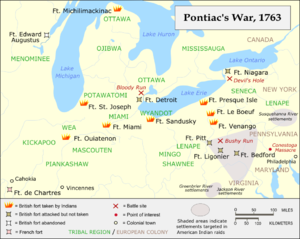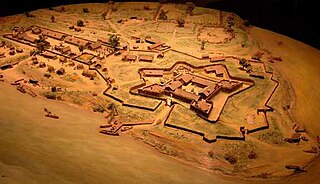
Fort Duquesne was a fort established by the French in 1754, at the confluence of the Allegheny and Monongahela rivers. It was later taken over by the British, and later the Americans, and developed as Pittsburgh in the U.S. state of Pennsylvania. Fort Duquesne was destroyed by the French before its British conquest during the Seven Years' War, known as the French and Indian War on the North American front. The British replaced it, building Fort Pitt between 1759 and 1761. The site of both forts is now occupied by Point State Park, where the outlines of the two forts have been laid in brick.

Pontiac's War was launched in 1763 by a loose confederation of Native Americans who were dissatisfied with British rule in the Great Lakes region following the French and Indian War (1754–1763). Warriors from numerous nations joined in an effort to drive British soldiers and settlers out of the region. The war is named after Odawa leader Pontiac, the most prominent of many indigenous leaders in the conflict.

Guyasuta was an important Native American leader of the Seneca people in the second half of the eighteenth century, playing a central role in the diplomacy and warfare of that era. Although he became friends with George Washington in 1753, he sided with the French against Britain during the French and Indian War and fought against the British in Pontiac's War. He later supported the British during the American Revolutionary War. In his final years, he engaged in peacemaking to end the Northwest Indian War.
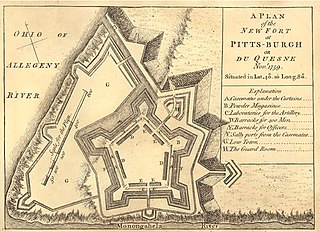
Fort Pitt was a fort built by British forces between 1759 and 1761 during the French and Indian War at the confluence of the Monongahela and Allegheny rivers, where the Ohio River is formed in western Pennsylvania. It was near the site of Fort Duquesne, a French colonial fort built in 1754 as tensions increased between Great Britain and France in both Europe and North America. The French destroyed Fort Duquesne in 1758 when they retreated under British attack.

French Creek is a tributary of the Allegheny River in northwestern Pennsylvania and western New York in the United States.

Fort Le Bœuf was a fort established by the French during 1753 on a fork of French Creek, in present-day Waterford, in northwest Pennsylvania. The fort was part of a line that included Fort Presque Isle, Fort Machault, and Fort Duquesne.
Fort Bedford was a French and Indian War-era British military fortification located at the present site of Bedford, Pennsylvania. The fort was a star-shaped log fortress erected in the summer of 1758.

The siege of Fort Detroit was an ultimately unsuccessful attempt by North American Natives to capture Fort Detroit during Pontiac's Rebellion. The siege was led primarily by Pontiac, an Ottawa chief and military leader. This rebellion would be one of the catalysts that hastened the declaration of the Proclamation of 1763 which would eventually precipitate the events leading to the American Revolution.

Fort Presque Isle was a fort built by French soldiers in summer 1753 along Presque Isle Bay in present-day Erie, Pennsylvania, to protect the northern terminus of the Venango Path. It was the first of the French posts built in the Ohio Country, and was part of a line that included Fort Le Boeuf, Fort Machault, and Fort Duquesne.
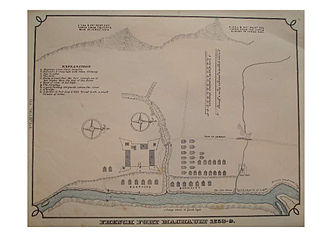
Fort Machault was a fort built by the French in 1754 near the confluence of French Creek with the Allegheny River, in northwest Pennsylvania. The fort helped the French control these waterways, part of what was known as the Venango Path from Lake Erie to the Ohio River. It was one of four forts designed to protect French access to the Ohio Country and connections between its northern and southern colonies. From north to south the forts were Fort Presque Isle, Fort Le Boeuf, Fort Machault, and Fort Duquesne, at the Forks of the Ohio. The fort was abandoned by the French in 1759, and burned so that the British could not use it. It was replaced by the British in 1760 with Fort Venango.
Fort Augusta was a stronghold in Northumberland County, Pennsylvania, in the upper Susquehanna Valley from the time of the French and Indian War to the close of the American Revolution. At the time, it was the largest British fort in Pennsylvania, with earthen walls more than two hundred feet long topped by wooden fortifications. With a garrison of over 300 troops and walls specially constructed to resist artillery, it presented a formidable defense and was never attacked. It served as a refuge for local settlers during the French and Indian War and during the American Revolutionary War. It was abandoned in 1780 and dismantled in 1796.
Custaloga was a chief of the Wolf Clan of the Delaware (Lenape) tribe in the mid-18th century. He initially supported the French at the beginning of the French and Indian War, but after Pontiac's War he participated in peace negotiations. He opposed the presence of Catholic missionaries, but later in life he became favorable to the Moravians. Captain Pipe was his nephew and succeeded him as chief.
Venango Path was a Native American trail between the Forks of the Ohio and Presque Isle, Pennsylvania, United States of America. The latter was located at Lake Erie. The trail, a portage between these important water routes, was named after the Lenape village of Venango, at the confluence of French Creek and the Allegheny River. The village site was later developed by European Americans as the small city of Franklin, Pennsylvania.

The French Creek Council serves Boy Scouts in six counties in northwestern Pennsylvania and one township in Ohio. The council was organized in 1972 from a merger of the former Washington Trail Council of Erie, Custaloga Council of Sharon and Colonel Drake Council of Oil City, Pennsylvania. It has headquarters in Erie, Pennsylvania.
The Battle of La Belle-Famille occurred on July 24, 1759, during the French and Indian War along the Niagara River portage trail. François-Marie Le Marchand de Lignery's French relief force for the besieged French garrison at Fort Niagara fell into Eyre Massey's British and Iroquois ambush. This action formed part of the larger Battle of Fort Niagara.
Philippe-Thomas Chabert de Joncaire, also known as Nitachinon by the Iroquois, was a French army officer and interpreter in New France who established Fort Machault in the 18th century. During his career, he largely served as a diplomat with the indigenous nations rather than as a soldier.
Keekyuscung aka Kickyuscung, Kaquehuston, Kikyuskung, Ketiuscund, Kekeuscund, or Ketiushund, was a Delaware (Lenape) chief. In the 1750s he took part in peace negotiations to end Lenape participation in the French and Indian War. In 1754 he briefly engaged in some spying and smuggled some letters into and out of Fort Duquesne for George Washington. He was sympathetic to the British for many years, but in 1763 he and his son Wolf sided with the French after a failed assassination attempt by Colonel Henry Bouquet. He is known for being one of the Native American leaders that attacked Colonel Bouquet's forces at the Battle of Bushy Run, where Keekyuscung was killed.
Fort Bigham was a privately built stockaded blockhouse fort constructed in 1754 near present-day Honey Grove in Tuscarora Township, Juniata County, Pennsylvania. It was built by Samuel Bigham on his land to protect his family and neighbors from Indians. In June, 1756 the fort was attacked and the people in it, mostly women and children, were all captured or killed. The fort was largely destroyed. It was rebuilt in 1760 and abandoned in 1763.
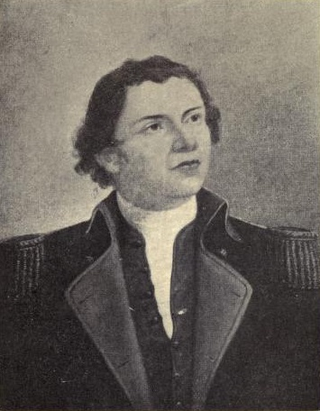
Mercer's Fort was a temporary fort built by Colonel Hugh Mercer during the winter of 1758–1759, to secure the "forks of the Ohio," at the confluence of the Monongahela River and the Allegheny River, where Mercer was preparing to build Fort Pitt. At the time it was loosely known as "the fort at Pittsburgh," and when work on Fort Pitt had progressed, it was sometimes referred to as "the first Fort Pitt." Only later did people call it "Mercer's Fort," leading to confusion with Fort Mercer in New Jersey. The fort initially served to defend the site, but as Fort Pitt neared completion, it was used mostly to lodge workers and to store supplies. In mid-1760 it was partially dismantled, with some buildings converted into a hospital.
Fort Henry was a stockade fort built in early 1756 in Berks County, Pennsylvania, to protect local settlers from Native American war parties, which were raiding the area frequently during the French and Indian War. It was one of the larger forts built in a defensive line, 12-20 miles apart, intended to safeguard the more densely-populated communities of the eastern Province of Pennsylvania. It was abandoned in 1759, and then briefly put back into use in 1763 during Pontiac's War.

